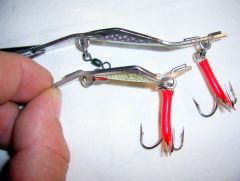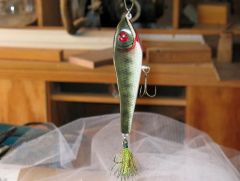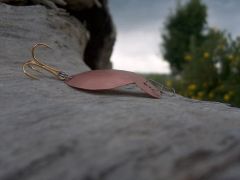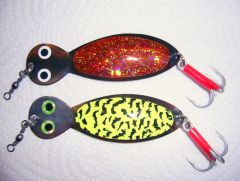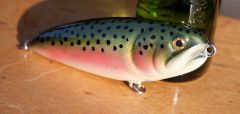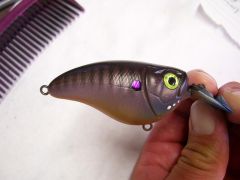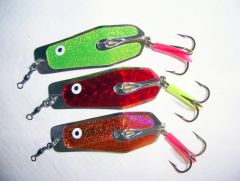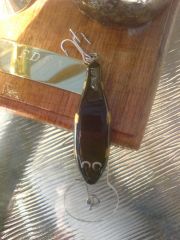-
Posts
14,726 -
Joined
-
Last visited
-
Days Won
364
Content Type
Profiles
Articles
TU Classifieds
Glossary
Website Links
Forums
Gallery
Store
Everything posted by mark poulson
-
The Createx trans. yellow will be perfect for what you want. Depending on which type of brush you have, turn both the paint needle and the air pressure down, until you get the right size spray for the distance away from the lure you paint, and a light enough spray to be able to go over it as much as you need without overdoing it, so you can build your color. Don't try to do it in one pass. The yellow is a strong color, and can quickly be too much, so take your time, and practice on a flat piece of material base coated the same as the lure. Before I try a new detail, I spray my lures with Krylon pastel fixative to protect the base coat and and scale pattern , so I can quickly wash it off if it's not right. Go light with the pressure and the paint, and it should be fine.
-
-
Yes, it's for a rattle. I got so involved with describing it right, I forgot to say what it was.
-
If you use PVC for your lure making, you can just drill a 1/4" hole, counter sunk with a 5/16" and 3/8" holes. You don't have to line the hole, or use a metal tube. I make sure the holes align by first drilling a small hole all the way through the lure blank, so they are in line. Then I drill the 3/8" shallow, followed by the 5/16', again shallow, and then the 1/4", half depth, and all centered on the small pilot hole. Repeat from the other side. Seal one end with a 5/16" disc. punched from an aluminum can (the end of an exacto knife works great for pushing the aluminum disc in) using brush on crazy glue, drop in a 1/4" sst ball bearing, and then seal the other end the same way. The brush on glue instead of the runny stuff will prevent the bearing from getting glued into place. Been there, done that. Then put a 3/8" eye over each aluminum rattle cap and, voila, you're done. Voila! I just love that word.
-
Davie, I thought I answered you two days ago. Man, it must be the anesthetic. For me, at least, the hardest part is figuring out what I want to do. In this case, I had already solved all the mechanical problems with the first ones I made, and they were just scaled down versions of some bigger lures that I've been making for a while. So the whole process was just mechanical. Shaping, sanding, weighting, finishing. I use a bandsaw, tablesaw, drill press, oscillating belt sander, and screw eyes, 1/4" lead wire, brush-on crazy glue, and a hole punch/aluminum can/ball bearing rattle system, and it goes really fast. On these lures I don't sweat the details. That's why I use sharpies for the gills and mouth details. I don't think a bass can tell the difference when it's gliding side to side so quickly, so it cuts way down on the time I would normally spend carving. Of course, now that I've said that, I'll probably have to carve one, just to prove to myself there's no difference.
-
John, I wasn't the only one. My buddy fished another tournament there two weeks ago, and won with 11+lbs. His kicker fish, a 4+, came on a Huddleson 8" ROF 12 trout. He said he ony had 8lbs until he got his kicker. It was big fish for the tournament. The guys who won with 19lbs had three over 5lbs., and two dinks.
-
-
Chatterbaits use exactly the same hole configuration and duolock snap, and I've never had one come unbuttoned yet. Of course, the chatterbait blade is free swinging, so the fish don't have the same leverage as with a metal spoon. My biggest fish on one was a 7lb largemouth that went completely under the boat and jumped on the other side. It was during a night tournament, and my partner almost had a heart attack. I fish them on 50lb braid, so the strain is all on the rod and the snap, and, so far, I haven't had any problems. My partner took some down to Lake Baccarrac in Mexico, and he said he had some fish that opened the snap down there. Of course, his best five one day went 49+lbs! I check the snaps all the time, just in case.
-
Very nice looking bait, at a great price. Can the tails be painted?
-
D2T is a glue. It's designed to be very rigid. If you want a top coat epoxy that is more flexible, look at Decoupage epoxies, like Etex or Nu Lustre 55. They are designed to be able to expand and contract with the movement of the large woodens surfaces that they cover, like table and bar tops. Also, rod building epoxies are designed to flex, hence the name Flexcoat.
-
Looks great!
-
John, I didn't get bit on it today. I had a limit of 8 1/2lbs, but couldn't get a kicker. Tough bite, at least for me. The guys who won it had 19lbs, and they ran the banks throwing reaction all morning. 6 hour tournament, launched at 5:45, first flight weigh in was 11:45. We got off the lake just in time. The temps climbed to the high 90s by the time the weigh in was over.
-
It is PVC. Ask you local lumber yard if they can get it for you. I don't worry about paint failures any more. Funny thing is, Createx paint, and all T shirt paints, are waterproof after they've been heat set, so the top coat is to protect the paint from scratching, and the PVC, with a rattle can primer, holds the paint really well. The tails are made from Krystal Flash, a fly tying material. It comes in a really wide variety of colors, is very reflective, and pulses a little, but not as much as a feather. It really flashes in the water. I used the tip from the color video that 68 King Fisher posted to add red to my avacado green to get a green pumpkin as the base color on the back and sholders. Amazing what actually knowing what you're doing can do for your paint mixing skills! I'm going out chasing the bass tomorrow, and I'll have this one tied on. Fingers crossed.
-
-
-
-
-
-
76gator, Trout will "tail" at the surface when they're just cruising along, following the shoreline, or sunning. They also hang just below the surface and feed on insects as they land on the water. And they will bust shad at the surface, just like bass or stripers. But they will literally jump out of the water and skid across the surface when a big predator, like a bass, has chased them up to the top. I've seen them actually run themselves aground to get away from bass. That's what makes surface gliders, like Jeep's, so effective. It looks like either an actively feeding trout, or one that's in distress and trying to escape. Either way, it's the dinner gong for big bass, and will bring them up from 30' depths in clear water. The bass sometimes comes up so fast it can launch itself out of the water and miss the lure completely, or just slap it to stun it on the way by, so it's important not to stop the retrieve until you feel the fish actually pull on the lure. Then set the hook. It is an exciting hit, when it happens. Like a turbo toilet flush.
-
Sounds like your epoxy isn't completely mixed. Try mixing it on some tape, applied to the work table you use. I lay out two parallel, equal lines of epoxy and hardener, and then use a wooden tooth pick to mix the two. I generally mix it in small, circular motions, and move the two components back and forth until it's completely mixed. I don't worry about creating bubbles. I think that if I mix it so gently that there are no bubbles, I don't mix it completely. Having said all that, glue epoxy like D2T is a really hard material to get right as a top coat. I'm lucky to get 5 minutes working time per batch. Do one lure at a time.
-
-

.......been working on some more spoons !
mark poulson commented on diemai's gallery image in Hard Baits
I have used the cast and retrieve, letting it fall to the level of the bait fish. I did have the hook/wire tangle once in a while, but it's not bad at all. The lake I fish have really rocky, snaggy bottoms, so I don't let it fall all the way down. Too precious to take a chance like that. The threadfin shad have moved back into the coves, and are starting to come up to the upper part of the water column, so now's the time the DinnerBell should shine. I'll use the aluminum template like you said to make a template for the prism tape. Thanks for the advice. -
I actually like the harder lead for jig heads. I don't pour, but Barlows sells unpainted lead heads that are a bit harder than lead sinkers, and they hold up really well for me. I also think it's a little louder than the soft lead, too. Kind of like tungsten, except cheaper. I buy 1/4" lead wire from Cabelas to use as ballast for my lures. Really easy to use. Just push it into a 1/4" hole, and add a drop of crazy glue, and, voila! Just my .
-
They both look great. Let your imagination guide you. It's not wrong if the fish eat it. I try to stick to local prey fish for guidance as to size, shape, and color schemes, and lean to bright white and chartruese for off colored water. That's about the only "genius" info I have to share. It looks like you've already got the rest.




